Nostoc is a cyanobacterium and is one of the oldest organisms on earth (over 3.5 billion years). It is a primitive growth, like algae, moss, and liverwort. Many years ago, it was incorrectly identified as blue-green algae. Nostoc has no roots, no vascular tissues & is not a plant but it is photosynthetic. It can be found growing within gravel, stones, limestone chips, granite, saturated soils & on-ground cloth within container nurseries. It can tolerate long periods of desiccation but requires plentiful amounts of water for establishment. This cyanobacterium growth can become common & persistent at certain nursery/greenhouse sites where long-term overhead irrigation is done.
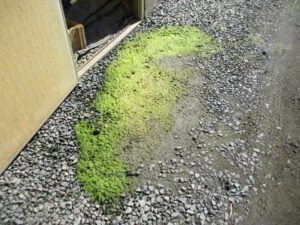
Nostoc growing in front of container bay opening. The opening allowed the overhead irrigation to saturate the soil/gravel at entrance. (Photo Credit: Steven K. Rettke, Rutgers Coop. Ext.)
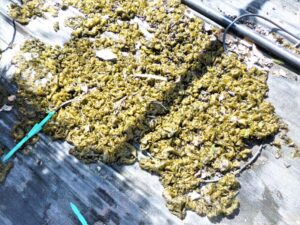
Nostoc growing on ground cloth within a nursery container bay. Creates a serious slipping hazard for nursery personnel. (Photo Credit: Steven K. Rettke, Rutgers Coop. Ext.)
Nostoc is not toxic & does not directly compete with nursery/greenhouse crops or landscape plants, but it can harbor fungus gnats & snails. Nostoc first became a growing concern in nurseries approximately 30 years ago. Slipping hazards are the primary threat this organism poses to nursery & greenhouse personnel. It forms gelatinous masses composed of filaments linked together by protective jelly-like coverings. This creates a surface as slick as wet ice. Nostoc can occasionally be found growing within turf or landscape settings but is not common.
This blog will show with photographic images how Nostoc can be identified & will also review available control options.
There are hundreds of Nostoc species that have been identified & they can be aquatic or terrestrial. It has been found growing on all the continents (including Antarctica). The species found growing in greenhouses & nurseries are usually assumed to be Nostoc commune, but the absolute species ID cannot be determined without genetic analysis. Knowing that Nostoc growth forms bubbles, as opposed to a smooth surface layer, helps to avoid confusing it with other growths such as moss, algae, or possibly other cyanobacteria.
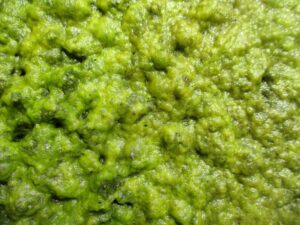
Nostoc up-close showing the bubbling-up of gelatinous filament masses with jelly-like coverings. (Photo Credit: Steven K. Rettke, Rutgers Coop. Ext.)
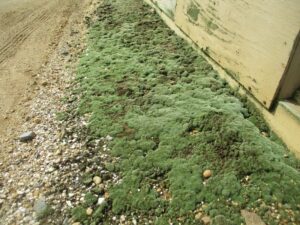
Moss & not Nostoc is growing at this nursery. The difference in appearance & texture is clearly evident at front of this container bay opening. Moss is not a slippery hazard. (Photo Credit: Steven K. Rettke, Rutgers Coop. Ext.)
Controlling Nostoc:
Until recently, there were few scientific journal publications on Nostoc control. Although mechanical raking can reduce growth, many herbicides do not work well. Some examples of herbicides that have shown to be ineffective or not dependable include glyphosate, Reward (diquat), Greenclean Pro (peroxide sanitizer), Sureguard, Marengo, & Scythe (pelargonic acid). Scythe applications have shown effective controls with some studies. Nostoc may have variable species at different locations that can cause different control results.

Saturated Nostoc with close-up of masses of gelatinous filaments. (Photo Credit: Steven K. Rettke, Rutgers Coop. Ext.)
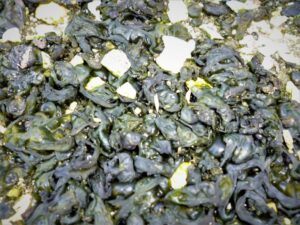
Noticeable change in color & appearance as this Nostoc mass shows signs of beginning to dry-out. (Photo Credit: Steven K. Rettke, Rutgers Coop. Ext.)
Funding provided by the IR-4 Project with research performed at N.C. State Univ. has shown some other herbicides that have shown satisfactory & more dependable suppression results against Nostoc. For example, the use of some of the copper compounds such as Captain XTR & Kalmor, an ammonium sanitizing agent (SA-20) & also diuron (Direx) will give fair to excellent suppression with multiple applications.
A Simple Solution?: Best Nostoc Control
Recent research results have shown that Finale XL (glufosinate) is the best post-emergent herbicide available in nurseries to control Nostoc (ref., North Carolina State University, Joe Neal & Chis Harlow (weeds.ces.ncsu.edu)). Finale XL is a non-selective herbicide & like glyphosate or diquat cannot be used within crop areas. The study showed that two applications at various concentrations will achieve controls up to 90-95% (no surfactant is needed). Finale does not control bittercress & is limited against liverworts. Nostoc must be moist (hydrated) for controls to work & when it dries out, post-control applications will not be effective.
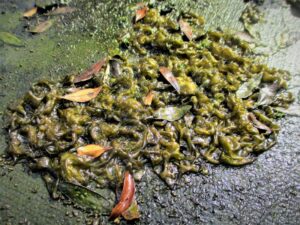
Moist, hydrated Nostoc mass growing on ground cloth within nursery container bay. Ideal condition for effective post emergent controls. (Photo Credit: Steven K. Rettke, Rutgers Coop. Ext.)

Nostoc showing a dehydrated condition. Post-control applications during this period will not be effective. (Photo Credit: Steven K. Rettke, Rutgers Coop. Ext.)
2021 North Carolina State University Research Results:
The Nostoc control research trials were an 8-week study that was conducted at various sites. The Nostoc was treated with 1x or 2x applications of Finale XL at concentration rates of 0.75, 1.0, 1.25, & 1.5 lbs. ai/A. (1.5 lb. ai/acre is the highest post-emergent label use rate in nurseries). The %-cover of Nostoc comparing the treated vs. non-treated areas within the nurseries was then evaluated over 8 weeks.
1st Trial Results:
-07/23 = 70% Nostoc coverage of test area (Pre-treatment)
Treatment with Finale XL (1.5 lbs. ai/acre w/1x app.)
-08/02 = 70% non-treated vs 55% coverage w/Finale
-08/12 = 70% non-treated vs 30% coverage w/Finale
-08/22 = 80% non-treated vs 20% coverage w/Finale
-09/01 = 75% non-treated vs 10% coverage w/Finale
-09/11 = 75% non-treated vs 5% coverage w/Finale
-09/21 = 70% non-treated vs 5% coverage w/Finale
Similar results were obtained with various other combinations of 0.75-1.5 lbs. ai/A & using either 1 or 2 applications. Therefore, the same excellent results were achieved when using even the lowest concentration of 0.75 lbs. ai/A with only a single application.
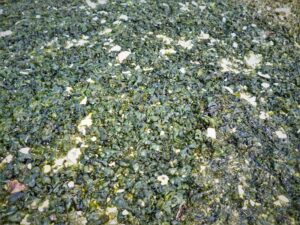
Non-treated Nostoc area showing more than 70% coverage at opening of nursery container bay. (Photo Credit: Steven K. Rettke, Rutgers Coop. Ext.)
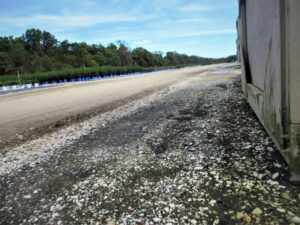
Nostoc a few weeks post control treatments starting to show significant coverage % reduction. (Photo Credit: Steven K. Rettke, Rutgers Coop. Ext.)
2nd Trial Results:
-05/20 = 80% Nostoc coverage of test area (Pre-treatment)
Finale XL (1.5 lbs. ai/acre w/1x app. & then 0.75 lbs. ai/A w/2x app.)
-08/01 = <5% Nostoc coverage
-09/01 = 10% Nostoc coverage (2x Finale treatment at 0.75 lbs. ai/A)
Within a short time then Nostoc coverage was reduced to 1%
Concluding Results: Finale XL has an 8–10-week residual & has a slow but consistent decline against Nostoc. After 8-10 weeks, controls of greater than 95% can be reached with a single application. A slight resurgence can occur as residual fades, but with a second application, a 99% reduction can be achieved. Typically, Nostoc commune will naturally stop growing for the season by mid-October in New Jersey.
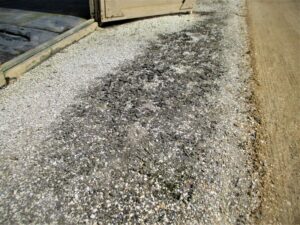
Nostoc area a couple of weeks post treatment beginning to show reduction & desiccation. (Photo Credit: Steven K. Rettke, Rutgers Coop. Ext.)
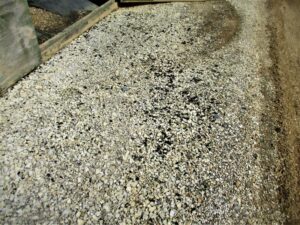
Two months after treatment the Nostoc area is nearly eliminated. (Photo Credit: Steven K. Rettke, Rutgers Coop. Ext.)
Reference: Webinar: “Controlling Nostoc, a slippery hazard for nursery workers,” by Joe Neal, North Carolina State University. The tHRIve web series, by the Horticultural Research Institute, October 4, 2022.
Reference: “Nostoc Control in Container Nurseries”, Joe Neal & Chris Harlow, North Carolina State University, I-R4 Funding, 2022.
Reference: Grower Talks, “Weeds & Liverwort & Nostoc, Oh My!”, Joe Neal, North Carolina State University, 8/1/2021.

